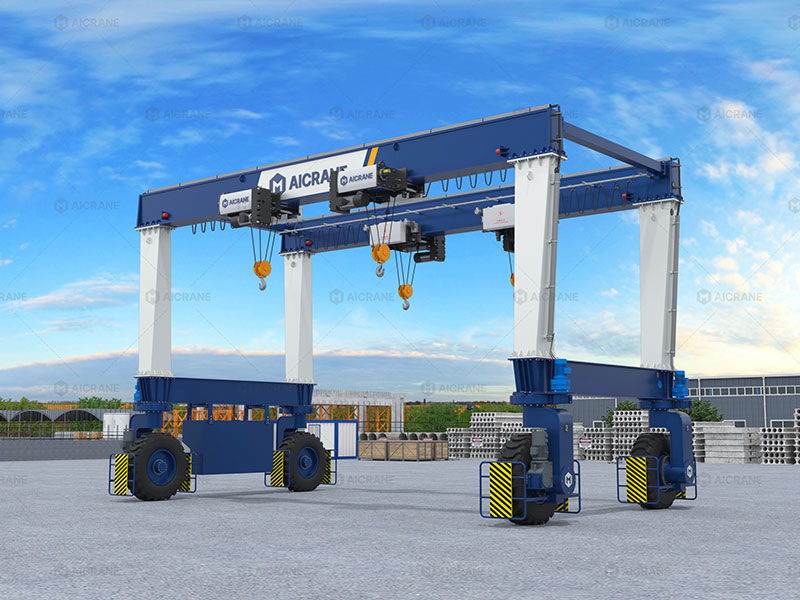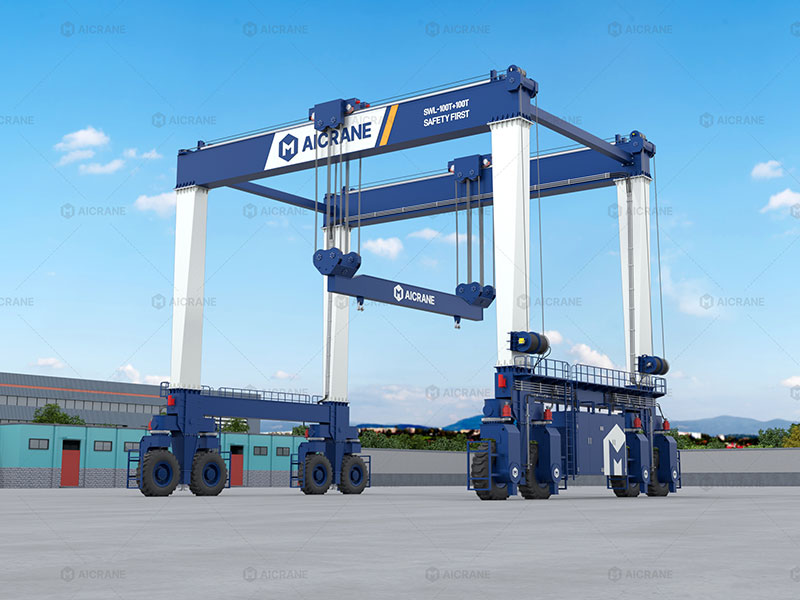Rubber Tyred Gantry (RTG) cranes have become an essential component of modern container terminals, offering high mobility, flexibility, and efficiency in handling containers. A critical factor influencing their performance, operational cost, and reliability is the type of drive system used. RTG cranes typically employ either hydraulic or electric drive systems, each with its advantages, limitations, and ideal application scenarios. This article explores the differences between hydraulic and electric drive systems for RTG cranes, providing insights into performance, energy efficiency, maintenance, and operational considerations.

Understanding RTG Crane Drive Systems
The drive system of an RTG crane is responsible for converting energy into motion, controlling the movement of the crane along its wheels, and ensuring smooth operations during container handling. Rubber tyred gantry cranes are complex machines that require precise control of multiple axes, including longitudinal movement (along the rail or yard), lateral travel (gantry span movement), trolley travel, and hoisting. The choice of a drive system directly affects how efficiently these movements are performed and the overall lifecycle costs of the crane.
Hydraulic drive systems utilize pressurized fluid to transmit power to hydraulic motors or cylinders that drive wheels and hoisting mechanisms. In contrast, electric drive systems use electric motors powered by onboard generators or external power sources, such as a cable reel, diesel-electric hybrid, or pure electric supply.
Hydraulic Drive Systems
Hydraulic drive systems have been a traditional choice for RTG cranes due to their simplicity and high power density. Key characteristics include:
-
High Torque at Low Speeds:
Hydraulic motors are excellent at providing high torque at low speeds, which is essential for lifting and moving heavy containers with precision. This makes hydraulic systems well-suited for applications requiring frequent start-stop movements. -
Compact Design:
Hydraulic components, including pumps, motors, and valves, are compact relative to their power output. This allows for a more streamlined crane design, particularly in older RTG models with space constraints. -
Load Sensing Capabilities:
Modern hydraulic systems can integrate load-sensing technology, enabling precise control of lifting and traveling speeds according to the weight of the container. This reduces the risk of overloading and enhances operational safety. -
Shock Absorption:
Hydraulic systems naturally absorb shocks and vibrations, providing smoother motion when lifting or moving containers, particularly in uneven yard surfaces.
Limitations of Hydraulic Drive Systems:
-
Energy Inefficiency:
Hydraulic systems can be less energy-efficient compared to electric systems due to energy loss in the form of heat during fluid transmission. High operating pressures and continuous pump operation contribute to increased fuel consumption in diesel-powered hydraulic RTGs. -
Maintenance-Intensive:
Hydraulic systems require regular maintenance to prevent leaks, contamination, and wear in pumps, valves, and hoses. Over time, hydraulic fluid degradation can impact performance. -
Environmental Concerns:
Hydraulic fluid leaks pose environmental risks, particularly in container yards with sensitive ground conditions or near water bodies.
Despite these limitations, hydraulic drive systems remain reliable in heavy duty gantry crane operations, especially in older cranes or scenarios where high torque at low speeds is essential.

Electric Drive Systems
Electric drive systems for RTG cranes have gained popularity in recent years due to technological advancements in power electronics, electric motors, and hybrid systems. Key features of electric drives include:
-
High Energy Efficiency:
Electric motors convert electrical energy into mechanical energy with minimal losses, achieving efficiencies up to 90% or higher. Hybrid diesel-electric RTGs combine a diesel generator with electric motors, significantly reducing fuel consumption compared to fully hydraulic systems. -
Precision and Control:
Electric drive systems allow precise speed and motion control through variable frequency drives (VFDs). Operators can achieve smooth acceleration, deceleration, and hoisting operations, improving container handling accuracy and reducing wear on crane components. -
Lower Maintenance Requirements:
Electric systems eliminate the need for hydraulic fluid, pumps, and hoses, reducing maintenance costs and minimizing the risk of leaks. Regular inspection of motors, cables, and electrical components is simpler and cleaner than maintaining hydraulic circuits. -
Environmentally Friendly:
Electric drive RTGs produce lower emissions, especially in fully electrified systems using shore power. This aligns with global efforts to reduce greenhouse gas emissions in ports and container terminals. -
Regenerative Braking:
Modern electric RTG cranes often include regenerative braking systems, which recover energy during trolley or gantry deceleration and feed it back into the power system. This feature further enhances energy efficiency and reduces operating costs.
Limitations of Electric Drive Systems:
-
High Initial Investment:
Electric and hybrid RTGs are generally more expensive upfront than traditional hydraulic RTGs, particularly for fully electrified systems with complex cabling and power distribution infrastructure. -
Power Supply Constraints:
Pure electric RTG cranes require continuous access to electricity, either via cable reels, conductor bars, or overhead power supplies. In ports where electrical infrastructure is limited, hybrid solutions may be necessary. -
Complex Electronics:
Advanced control systems, power electronics, and sensors in electric drives demand skilled technicians for troubleshooting and repair. Malfunctions in control software can lead to operational downtime.
Performance Comparison: Hydraulic vs. Electric
When comparing hydraulic and electric drive systems for RTG gantry crane for sale, several performance metrics are worth considering:
| Feature | Hydraulic Drive | Electric Drive |
|---|---|---|
| Torque at low speed | High | Moderate (but sufficient with proper motor sizing) |
| Energy efficiency | Moderate to low | High |
| Maintenance frequency | High | Low |
| Precision & control | Moderate | High |
| Initial investment | Low to moderate | High |
| Environmental impact | Higher (hydraulic fluid risk & fuel) | Lower (reduced emissions, regenerative braking) |
| Shock absorption | Excellent | Moderate (depends on control system) |
Electric drives dominate in energy efficiency, precision, and environmental friendliness, while hydraulic drives remain competitive in providing high torque and simplicity for traditional RTG operations.
Choosing the Right System for Your RTG Crane
The choice between hydraulic and electric drive systems depends on operational priorities, yard conditions, budget constraints, and long-term sustainability goals. Consider the following factors:
-
Operational Requirements:
High-speed container stacking and frequent precise positioning favor electric drives with VFDs. Heavy load handling with less emphasis on energy efficiency may benefit from hydraulic drives. -
Yard Layout:
In compact terminals with tight spaces, the smooth and shock-absorbing motion of hydraulic systems can reduce wear on container stacks and infrastructure. Conversely, electrified yards benefit from lower emissions and cleaner operations with electric RTGs. -
Energy Costs and Environmental Regulations:
Ports with high electricity availability and strict environmental standards are ideal candidates for electric or hybrid RTG port gantry cranes. High fuel costs also favor electric systems due to their superior efficiency. -
Maintenance Capability:
Electric RTGs require electrical expertise, while hydraulic systems demand mechanical and fluid system maintenance. Terminal operators must evaluate local technical capabilities before selecting a drive system. -
Lifecycle Cost Analysis:
While hydraulic RTGs may have lower initial costs, electric RTGs often outperform them in total cost of ownership due to fuel savings, lower maintenance, and potential government incentives for green equipment.
Conclusion
Hydraulic and electric drive systems for RTG cranes each offer distinct advantages and trade-offs. Hydraulic systems provide high torque, excellent shock absorption, and simplicity but are less energy-efficient and maintenance-intensive. Electric drive systems, especially hybrid or fully electrified solutions, excel in precision, energy efficiency, environmental friendliness, and lower maintenance but require higher upfront investment and access to reliable electrical infrastructure.
In the evolving landscape of container terminals, where energy costs, environmental regulations, and operational efficiency are critical, electric drive RTGs are increasingly preferred for new installations. However, hydraulic systems still maintain a strong presence in older cranes and heavy-duty operations where torque and mechanical simplicity are paramount. Ultimately, terminal operators must carefully assess their operational priorities, maintenance capabilities, and financial constraints to select the drive system that best aligns with their long-term goals.
